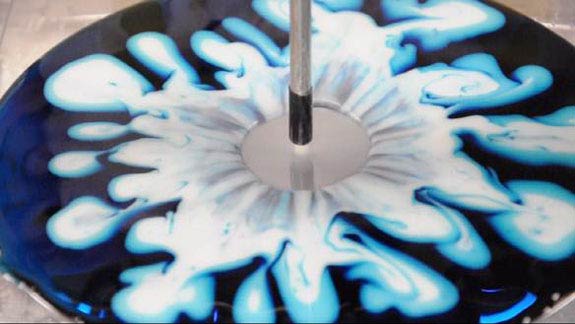Rinsing Flow Image of Water
Travis Walker
Theresa Hsu
Gerald Fuller
Department of Chemical Engineering
Stanford University

Dyed water (white) impinging on a solution of polyacrylamide (PAM) (blue).
The photograph shows a jet of water (white) rinsing a diluted solution of polyacrylamide (PAM) (blue) off of a surface made of silicon. Dilute solutions of high-molecular weight PAM have highly elastic properties that create interesting flow physics, as seen in this image.
Both the rinsing solution (water) and the solution coating the substrate (PAM) undergo what is called a hydraulic jump, seen at the outer edge of the clear circular area in the center of the picture. At this transition, the flow abruptly rises in height as it changes from a high-velocity laminar flow (in which the streamlines of flow are parallel and do not disturb one another) to a low-velocity turbulent flow (a less-orderly flow with swirls and eddies that promote mixing). The authors took this image in an attempt to view the undercutting of the water as it initially impinges on the solution of PAM; but the vortical mixing and the formation of viscous fingers provided a beautiful image.
The type of flow featured in this image has practical applications as well. The simple addition of a high-molecular weight polymer, such as PAM, to a liquid that coats a surface could be used to more gently and easily remove contaminants from that surface. The coating would work as a soft adhesive that, when rinsed off, would remove particulates from the surface without harming it.
Reporters and Editors
To use this image please contact:
Travis W. Walker
Stanford University
605.840.6253
twwalker@stanford.edu
Associated References
- Walker, T.W., T.T. Hsu, C.W. Frank, G.G. Fuller. Role of shear-thinning on the dynamics of rinsing flow by an impinging jet. Phys. Fluids. 24 (9), 2012. DOI:10.1063/1.4752765.
- Hsu, T.T., T.W. Walker, C.W. Frank, G.G. Fuller. Role of fluid elasticity on the dynamics of rinsing flow by an impinging jet. Phys. Fluids. 23 (3), 2011. DOI:10.1063/1.3567215.
